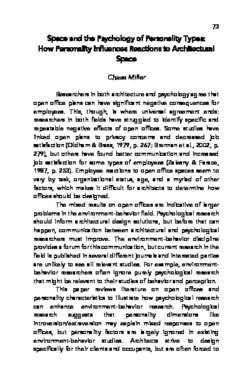| dc.contributor.author | Miller, Chase | |
| dc.date.accessioned | 2016-06-12T18:53:02Z | |
| dc.date.accessioned | 2021-04-14T14:29:49Z | |
| dc.date.available | 2016-06-12T18:53:02Z | |
| dc.date.available | 2021-04-14T14:29:49Z | |
| dc.date.issued | 2016 | |
| dc.identifier.uri | https://hdl.handle.net/11244.46/91 | |
| dc.description | Copyright © 2016, The Honors Undergraduate Research Journal, University of Oklahoma. All rights revert to authors. | en_US |
| dc.description.abstract | Researchers in both architecture and psychology agree that
open office plans can have significant negative consequences for
employees. This, though, is where universal agreement ends:
researchers in both fields have struggled to identify specific and
repeatable negative effects of open offices. Some studies have
linked open plans to privacy concerns and decreased job
satisfaction (Oldham & Brass, 1979, p. 267; Brennan et al., 2002, p.
279), but others have found better communication and increased
job satisfaction for some types of employees (Zalesny & Farace,
1987, p. 253). Employee reactions to open office spaces seem to
vary by task, organizational status, age, and a myriad of other
factors, which makes it difficult for architects to determine how
offices should be designed. | en_US |
| dc.description.abstract | The mixed results on open offices are indicative of larger
problems in the environment-behavior field. Psychological research should inform architectural design solutions, but before that can happen, communication between architectural and psychological researchers must improve. The environment-behavior discipline provides a forum for this communication, but current research in the field is published in several different journals and interested parties are unlikely to see all relevant studies. For example, environment-behavior researchers often ignore purely psychological research that might be relevant to their studies of behavior and perception. | en_US |
| dc.description.abstract | This paper reviews literature on open offices and
personality characteristics to illustrate how psychological research can enhance environment-behavior research. Psychological research suggests that personality dimensions like introversion/extraversion may explain mixed responses to open offices, but personality factors are largely ignored in existing environment-behavior studies. Architects strive to design specifically for their clients and occupants, but are often forced to guess about how occupants will respond to a space. Improved communication between designers and psychologists may lead to better understanding of how different people react to the same architectural spaces. | en_US |
| dc.description.sponsorship | The Honors Undergraduate Research Journal (THURJ) is a publication of the Joe C. and Carole Kerr McClendon Honors College at the University of Oklahoma. The views expressed in THURJ are solely those of the contributors and should not be attributed to the Editorial Staff, the Honors College, or the University of Oklahoma. | en_US |
| dc.language.iso | en_US | en_US |
| dc.relation.ispartofseries | THURJ: The Honors Undergraduate Research Journal;Volume 15 | |
| dc.rights | Attribution-NonCommercial-ShareAlike 3.0 United States | * |
| dc.rights.uri | https://creativecommons.org/licenses/by-nc-sa/3.0/us/ | * |
| dc.subject | Open Offices | en_US |
| dc.subject | Personality Characteristics | en_US |
| dc.subject | Psychological Research | en_US |
| dc.subject | Environment-behavior Research | en_US |
| dc.title | Space and the Psychology of Personality Types: How Personality Influences Reactions to Architectural Space | en_US |
| dc.type | Article | en_US |
| dc.description.undergraduate | undergraduate | |

